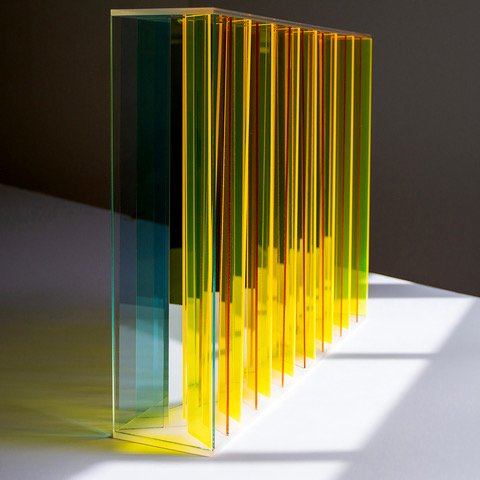WHERE ART INSPIRES CONNECTION

Perception Illuminated
featuring work by
Betsy Kenyon
Blanca Estela Rodríguez
June 15 - August 13, 2023
TINT is pleased to announce “Perception Illuminated,” featuring works by Betsy Kenyon and Blanca Estela Rodríguez. Through different media, these artists play with perception by sculpting light. In a darkroom, Kenyon records momentary gestures onto photographic paper. The heavy penumbra between areas of light and dark reads as shading, which creates an illusion of form, space, and light. Rodríguez uses colored acrylic glass to create sculptures that seem to be illuminated. Her works offer limitless shifts in perception based on light, shape, time, and proximity.
In luminous acrylic glass works, Rodríguez creates metaphorical spaces that reductively explore the illusion of a stable reality. Despite static architectural shapes and lines, that which is solid seems to dissolve and the viewer’s experience is never quite the same depending on the atmospheric elements. Shapes appear to bend as reflections confuse boundaries, and shadows complicate the core structures of each sculpture.
The shifts in perception based on light, shape, and proximity mimic the complex interplay of intention and reception in cross cultural communication, understanding, and experience. This mirrors Rodríguez’s own ever evolving identity; enriched by each country she has inhabited, and received differently depending upon time, place, cultural and linguistic nuance. The hypnotizing ways in which Rodríguez’s work plays with perception invites the viewer into imaginary, almost private spaces. The shifting beauty is both structural and atmospheric; projections and preconceptions, real and imagined facts, play tricks on the mind and color the experience.
Kenyon’s work is a merging of different processes; it challenges distinctions between 2-dimensional and 3-dimensional experiences, capturing normally imperceptible time events. Using darkroom techniques as her medium, Kenyon blurs established lines between drawing, painting, photography, and sculpture. Each darkroom print is one of a kind, made without a negative. Each part of the image is a unique, split-second, exposure/gesture where incremental advances become differences in tonal value and ultimately differences in a perceived visual space. Even though Kenyon’s works are produced chemically in a darkroom, Kenyon refers to them as “darkroom drawings” because they feel less photographic and more drawing-like to her.



